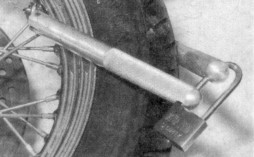
No, you're not a bad person! Nobody gets it right the first time around! You might have thought,
since Bell was in the name, that it had something to do with the phone company - and so
was high tech. You didn't know that difference between a DX and an SX 486.
Or the difference between a 100 meg. or a 300 meg. hard drive. The
sale price seemed great, but you got stuck with 4 megs of RAM,
no CD-ROM and a 2400 Baud modem - bottom of the
barrel, even by the standards of two years ago.
|
Maybe WINDOWS 3.1 never ran right?
Maybe the hard drive ran out of space over a year ago?
Maybe you want to play a game that requires 256 colors?
Maybe the local BBS or ISP has given up on "slow" modems, shutting you out? Maybe the new
software
that you want to install only comes on CD? Or maybe your child or spouse or significant other has voiciferously informed you that he/she is no longer going to use that old clunker of a Packard Bell! And thereupon appropriated your new Pentium! What to do? Should you buy a new machine? Maybe yes. Maybe no. The one essential flaw in the Packard Bell - as far as repair or upgrade is concerned is the design of the shape of the motherboard, case, and power supply. These components are all made to fit together like pieces from a jigsaw puzzle (BTW, the same goes for COMPAQs, DELLs, and IBMs). If the power supply or the motherboard goes, you might as well put together a new machine. Packard Bell (along with the other big names) charges very high prices for these parts. The incidental, though not superficial, flaw was that most Packard Bells were sold woefully lacking in hardware firepower. I presume this to have been part of a marketing strategy. First time buyers would look for a "486" and a low price. That they were getting a neutered system, with CPU, RAM, hard drive, modem all shortweighted, would come as a nasty suprise down the road. This can be, if not cured, at least, remedied. The 486SX 25 processor that graced most Packard Bells was inadequate even at the time of purchase. The SX version of the 486 lacked a functional math co-processor. This slows down all sorts of things, Spread sheets, data bases, the user-interface in WINDOWS, and lots more. And at a speed of 25 mhz., you don't have any speed to be slowing down with! Pefrectly functional 486DX 50 and 66 processors can be found on USENET and at computer shows for $10 - $20. The 80 and 100 mhz. versions change hands at maybe an extra $10. This will be like enrolling the 98 pound weekling 486SX 25 into the CHARLES ATLAS body building course! And if you feel like spending money, Intel OverDrive PENTIUM processors work in many Packard Bell systems. THIS OLD 486 provides a complete discussion of swapping CPUs. Here I'll give some pointers that are especially important concerning performing this operation on a Packard Bell. All electronic gear can be damaged/destroyed by static elecricity (also called ESD or Electro Static Discharge). Packard Bell motherboards seem to be particularly easy to fry! Before you open the case of your system, touch a radiator or other water pipe. This will draw electicity out of your body. When touching the actual components, try to only handle the ceramic, plastic, fiber, or other non-metallic surfaces. Do the actual work with the system on a wood, plastic, or other non-conductive surface. And always make sure that the plug is pulled out of the wall. Don't just turn the computer off! If the power goes on while you are inserting or removing a device, any number of things can be ruined!
New Jersey Short Stories
 $25 – Lock Included – Free Shipping in the USA Payment by PayPal – E-mail anthony.olszewski@gmail.com


 Political corruption is a tradition here. First issue in a series by Anthony Olszewski – Click HERE to find out more.

|
|
 |
Before you install the new CPU, you will have to set jumpers on the motherboard for the CPU speed and the bus speed. Before you do anything else, WRITE DOWN THE CURRENT SETTINGS! Most older Packard Bells have a label inside the case cover explaining the jumper settings. I've found that these printed directions are sometimes wrong! If you install a new processor and nothing works, you might have to resort to trial and error to determine the correct jumpers. |
Basically all Packard Bell motherboards used 5 volt CPUs. That's fine for most used 486
processors,
but watch out. If you do get a 3 volt chip, you'll need a voltage regulator to put between the
CPU and the system board. 5 volts will surely destroy a 3 volt chip!
RAM is the easiest and most important upgrade to do. And now it is also the cheapest. Packard
Bells generally were sold with 4 megs of RAM (memory) built into the motherboard. A number
of
slots for 72 pin SIMMs are provided on the motherboard. SIMMs are described as having
pins, but they really don't.
SIMM memory is really a little circuit board with a gold-edged ("finger") connector surface.
Most Packard Bells require
parity memory, though some will allow the use of non-parity. All vendors of
computer memory know what these terms mean. If you have the choice between parity and
non-parity RAM, you will be better off with the parity version. But you will pay more for it.
You can buy the SIMMs anywhere. You don't need to
get them from Packard Bell.
With perhaps the majority of Packard Bell systems, each SIMM slot operates independantly. On
some,
the SIMM slots are organized into banks - sets of two or four slots. In each bank the
same capacity (one meg, 2 meg, 4 meg, etc.) and the same type (parity or non-parity) of RAM
must
be used. The banks need to be filled in a certain order and with certain sizes of memory chips.
This is in the manual for the individual system.
The original 4 megs was not ever good enough! At least 8 megs is required for the
proper
operation of WINDOWS 3.1. The difference in performance between 8 and 16 megs is very
noticable.
If you are aiming for WINDOWS 95 get 16 megs. Really, every system in use today
should
have at least 16 megs of RAM! The more memory the better. Though, most often, the benefits
are
much less apparent. When you go from 8 megs to 16 megs of RAM, performance is doubled. To
gain
the same amount of speed jump again, you'd probably need to go from 16 to something like 64
megs.
But memory is now very economical. Buy as much as you can!
To actually install the new memory (again, as always, taking precautions against ESD and making
certain that the plug is pulled), first locate the SIMM slots. On a desktop (as opposed to a
tower),
you might have to remove the sound card (and any other adapters) to gain access. The SIMM
slots are
white plastic a row of little metal teeth inside. You place the new SIMM inside the slot, lining
the notch in the center of the SIMM with the bump in the middle of the slot. Hold the SIMM in
at a
forty-five degree angle with the bottom edge of the SIMM firmly inserted into the slot. Then
carefully lift the SIMM into the holder until the snaps catch into the holes on either side ot the
SIMM. DON'T SNAP THE PLASTIC SIMM HOLDER! There is no economical way
to fix it if you break
it!
Most programs today (and basically ALL games and multi-media applications) expect the video
to be able to handle 256 colors. You can first just try to reset this in WINDOWS or
to download
new video drivers from Packard Bell. If this does not help new video memory can be
installed.
There is a series of sockets on the motherboard for upgrading the video RAM. Video RAM is a
little delicate and not widely available. It's easier to simply install a new card. Again, look
on the inside of the case cover (or silk-screened on the motherboard) for a jumper that disables
on-board video. You'll problably need an ISA card. Your Packard Bell might be able to use
a VLB card. Make sure that the new card
has at least one meg of RAM on it already. Any particular SVGA card might fail to deliver the
256
colors to any particular system. You can try different drivers. Make sure that the vendor will
allow a return if your new card
turns out to be a flop.
In most cases, unless your monitor is way over 14 inches, the 640 X 480 setting is fine. I think
that the 800 X 600 and 1024 X 768 are only realistic on 20" displays, but it's your eyesight!
Installing a bigger hard drive is not hard (to do). If you have a
desktop,
there might not be room to put in a second hard drive. Then you will have to remove the original
and put the new on in its place. With a tower, or a desktop without a CD drive, the new hard
drive
can be installed on the same cable as the old one. The 5.25" floppy drive might have to be
taken out to make room for a second hard drive.
If you want to install a CD ROM drive, again with a desktop, make sure that you have the space.
It's a good idea to buy the CD ROM drive and the sound card at the same time. This way you
know that
they will work together. Or at least you only have to make one trip to return the duds! If you have
a single hard drive, the new CD ROM will hook up ( as SLAVE)
on the same IDE cable as the hard drive. If you have two hard drives, make sure that the CD can
interface with (be connected to) the sound card. If the CD is hooked up to the sound card, it is
set as MASTER.
The easiest way to up the modem speed is to buy an external modem and just plug it into
the two (9 pin or 25 pin) serial port. First run MSD (MicroSoft Diagnostics) from DOS
(the
C prompt). Go into COM PORTS. If the UART is listed as 16550 (or some variant), then an
external
modem will work OK. If the UART is a 8250, then you really need to
install a new internal modem.
Go into the Packard Bell's system SETUP and DISABLE either a serial port or the existing
(factory
installed) modem. Set the new modem to whatever COM PORT the device had that you
disabled.
|
COMPUTERCRAFT |
|
|

Bruce Springsteen's Jersey Shore Rock Haven!
Very brandable Domains for Sale -- The GET NJ family of Sites, managed by Anthony Olszewski, features tens of thousands of Pages Online at dozens of active domains, many with a New Jersey focus. Other advertising opportunities – including enterprise and exclusive placements – exist at a wide range of Web Sites. Your ad can appear at one Page or at many, many thousands of Pages simultaneously! A large slice of the domains have been Online for more than five years, some for over ten! In addition to advertising, many great Domains are available for purchase or license Text Link Advertising Program Business name, Web Site Link and a brief description or motto – runs for one month in the Page (or Pages) of your choice. Hudson County Politics From Frank Hague to Robert Janiszewski, in this New Jersey county, political corruption is a tradition. Former NJ Governor Brendan Byrne wants to be buried here so he can stay active in Democratic politics! You'll find lots about Senator Robert Menendez, too. GRAVE ROBBER Jersey City Computer Repair 297 Griffith Street, Jersey City, NJ - 201-798-2292 - In the Heights just off of Kennedy Blvd. - Very close to Journal Square and Union City, just five minutes away from Hoboken, Downtown Jersey City, Newport, the Waterfront, Secaucus, North Bergen and Weehawken - Tech support for The Jersey City Mayor's Office during the administration of Bret Schundler - PC repair - Tivos, too!, upgrade, hardware install, software install, data recovery, spyware removal, virus removal, replace hard drive, replace motherboard, data recovered from notebook computers, recover lost XP passwords, password recovery |

Visit Liberty State Park!

For All Sorts of Unique New York City Information, Visit GET NY! |







